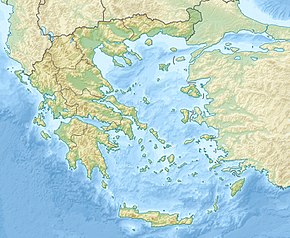Delfi
Delfi (bahasa Yunani: Δελφοί [ðelˈfi]), dalam legenda juga dikenal dengan sebutan Fito (Πυθώ), adalah sebuah kawasan keramat di Yunani Kuno yang dikenal sebagai tempat berkedudukannya Pitia, seorang peramal yang diandalkan oleh banyak orang pada zaman kuno untuk mengambil keputusan. Bangsa Yunani Kuno menganggap Delfi sebagai pusat dunia, seperti yang ditandai oleh sebuah tugu batu yang disebut omfalos (pusar). Kawasan keramat ini terletak di kawasan Fokis, tetapi manajemen kawasan ini kemudian diambil alih dari penduduk Fokis (yang mencoba mengambil uang dari para pengunjung) oleh Liga Amfiktonia atau komite yang anggotanya berasal dari Yunani Tengah. Menurut ensiklopedia Suda, nama Delfi berasal dari Delfin, yaitu seekor naga yang konon pernah tinggal di kawasan tersebut dan kemudian dibunuh oleh dewa Apollo (dalam kisah lain, makhluk tersebut bernama Piton).
Δελφοί | |
 Kompleks kuil Atena (termasuk Tolos Delfi ynag terkenal). | |
| Lokasi | Fokis, Yunani |
|---|---|
| Koordinat | 38°28′56″N 22°30′05″E / 38.4823°N 22.5013°E |
| Jenis | Reruntuhan |
| Sejarah | |
| Budaya | Yunani Kuno |
| Catatan situs | |
| Arkeolog | Sekolah Prancis di Athena |
| Pemilik | Republik Yunani |
| Pengelola | Kementerian Budaya dan Olah Raga |
| Akses umum | Dapat diakses dengan membayar tiket masuk |
| Situs web | E. Partida (2012). "Delphi". Odysseus. Ministry of Culture and Sports, Hellenic Republic. Diarsipkan dari versi asli tanggal 2007-10-01. Diakses tanggal 2021-02-13. |
| Nama resmi: Situs Arkeologi Delfi | |
| Jenis | Budaya |
| Kriteria | i, ii, iii, iv and vi |
| Ditetapkan | 1987 (sesi ke-12) |
| No. Referensi | 393 |
| Negara anggota | Yunani |
| Region | Eropa |
Kawasan keramat ini berada di lereng barat daya Gunung Parnasos. Kini situs ini menjadi situs arkeologi yang terletak tidak jauh dari sebuah kota kecil modern dengan nama yang sama. Kawasan keramat Delfi diakui sebagai Situs Warisan Dunia oleh UNESCO karena dianggap telah berpengaruh besar terhadap sejarah Yunani Kuno.
Referensi
- Broad, William J. The Oracle: Ancient Delphi and the Science Behind its Lost Secrets, New York : Penguin, 2006. ISBN 1-59-420081-5.
- Burkert, Walter (1985). Greek Religion.
- Connelly, Joan Breton, Portrait of a Priestess: Women and Ritual in Ancient Greece, Princeton University Press, 2007. ISBN 0691127468
- Call of Duty: Black Ops 4 (2018) "Ancient Evil"
- Dempsey, T., Reverend, The Delphic oracle, its early history, influence and fall, Oxford: B.H. Blackwell, 1918.
- Castro Belen, Liritzis Ioannis and Nyquist Anne (2015) Oracular Functioning And Architecture of Five Ancient Apollo Temples Through Archaeastronomy: Novel Approach And Interpretation Nexus Network Journal, Architecture & Mathematics, 18(2), 373-395 (DOI:10.1007/s00004-015-0276-2)
- Farnell, Lewis Richard, The Cults of the Greek States, in five volumes, Clarendon Press, 1896–1909. (Cf. especially, volume III and volume IV on the Pythoness and Delphi).
- Fearn, David (2007). Bacchylides: Politics, Performance, Poetic Tradition. Oxford University Press. ISBN 9780199215508.
- Fontenrose, Joseph Eddy, The Delphic oracle, its responses and operations, with a catalogue of responses, Berkeley: University of California Press, 1978. ISBN 0520033604
- Fontenrose, Joseph Eddy, Python; a study of Delphic myth and its origins, New York, Biblio & Tannen, 1974. ISBN 081960285X
- Goodrich, Norma Lorre, Priestesses, New York: F. Watts, 1989. ISBN 0531151131
- Guthrie, William Keith Chambers, The Greeks and their Gods, 1955.
- Hall, Manly Palmer, The Secret Teachings of All Ages, 1928. Ch. 14 cf. Greek Oracles, www, PRS
- Harissis H. 2015. “A Bittersweet Story: The True Nature of the Laurel of the Oracle of Delphi” Perspectives in Biology and Medicine. Volume 57, Number 3, Summer 2014, pp. 295-298.
- Harissis, H. (2019). "Pindar's Paean 8 and the birth of the myth of the first temples of Delphi". Acta Classica: Proceedings of the Classical Association of South Africa. 62 (1): 78 - 123.
- Herodotus, The Histories
- Homeric Hymn to Pythian Apollo Diarsipkan 2008-10-25 di Wayback Machine.
- Kase, Edward W. (1970). A Study of the Role of Krisa in the Mycenaean Era (Tesis Master's Thesis). Loyola University. Docket 2467. https://ecommons.luc.edu/cgi/viewcontent.cgi?article=3466&context=luc_theses.
- Liritzis, I; Castro, Β (2013). "Delphi and Cosmovision: Apollo's absence at the land of the hyperboreans and the time for consulting the oracle". Journal of Astronomical History and Heritage. 16 (2): 184–206. Bibcode:2013JAHH...16..184L.
- Lloyd-Jones, Hugh (1976). "The Delphic Oracle". Greece & Rome. 23 (1): 60–73. doi:10.1017/S0017383500018283.
- Manas, John Helen, Divination, ancient and modern, New York, Pythagorean Society, 1947.
- Miller, Stephen G. (2004). Ancient Greek Athletics . New Haven and London: Yale University Press.
- Parke, Herbert William (1939). A history of the Delphic oracle. Oxford: Basil Blackwell.
- Plutarch "Lives"
- Rohde, Erwin, Psyche, 1925.
- Seyffert, Oskar, "Dictionary of Classical Antiquities" Diarsipkan 2009-02-25 di Wayback Machine., London: W. Glaisher, 1895.
- Spiller, Henry A., John R. Hale, and Jelle Z. de Boer. "The Delphic Oracle: A Multidisciplinary Defense of the Gaseous Vent Theory." Clinical Toxicology 40.2 (2000) 189–196.
- Suess, Eduard (1904). Sollas, W J, ed. The face of the earth (Das antlitz der erde). Volume I. Diterjemahkan oleh Sollas, Hertha B C. Oxford: Clarendon Press.
- Suess, Eduard (1906). Sollas, W J, ed. The face of the earth (Das antlitz der erde). Volume II. Diterjemahkan oleh Sollas, Hertha B C. Oxford: Clarendon Press.
- Suess, Eduard (1908). Sollas, W J, ed. The face of the earth (Das antlitz der erde). Volume III. Diterjemahkan oleh Sollas, Hertha B C. Oxford: Clarendon Press.
- Suess, Eduard (1909). Sollas, W J, ed. The face of the earth (Das antlitz der erde). Volume IV. Diterjemahkan oleh Sollas, Hertha B C. Oxford: Clarendon Press.
- West, Martin Litchfield, The Orphic Poems, 1983. ISBN 0-19-814854-2.
